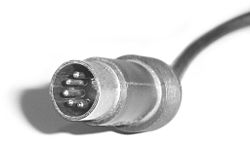
DIN Sync
Encyclopedia

The SYNC standard, often called "DIN sync" or "sync24" (more rarely "sync48"), defines an interface
Electrical connector
An electrical connector is an electro-mechanical device for joining electrical circuits as an interface using a mechanical assembly. The connection may be temporary, as for portable equipment, require a tool for assembly and removal, or serve as a permanent electrical joint between two wires or...
for electronic music
Electronic music
Electronic music is music that employs electronic musical instruments and electronic music technology in its production. In general a distinction can be made between sound produced using electromechanical means and that produced using electronic technology. Examples of electromechanical sound...
instruments. It was introduced in the 1980s by Roland Corporation
Roland Corporation
is a Japanese manufacturer of electronic musical instruments, electronic equipment and software. It was founded by Ikutaro Kakehashi in Osaka on April 18, 1972, with ¥33 million in capital. In 2005 Roland's headquarters relocated to Hamamatsu in Shizuoka Prefecture. Today it has factories in Japan,...
for synchronization of music sequencer
Music sequencer
The music sequencer is a device or computer software to record, edit, play back the music, by handling note and performance information in several forms, typically :...
s, drum machine
Drum machine
A drum machine is an electronic musical instrument designed to imitate the sound of drums or other percussion instruments. They are used in a variety of musical genres, not just purely electronic music...
s, arpeggiators and similar devices. The SYNC standard uses the signals clock (or tempo) and start/stop (or run/stop). The signals are TTL
Transistor-transistor logic
Transistor–transistor logic is a class of digital circuits built from bipolar junction transistors and resistors. It is called transistor–transistor logic because both the logic gating function and the amplifying function are performed by transistors .TTL is notable for being a widespread...
compatible. This means the low state is 0 V, the high state is about +5 V. The clock signal (2.51 V, 24ppqn for Roland gear) defines the speed of the sequence or drum pattern. The start/stop signal defines if the sequence is running (start/stop = 0 V → stop, start/stop = +5 V → running).
The SYNC standard uses 5 pin DIN connector
DIN connector
A DIN connector is a connector that was originally standardized by the , the German national standards organization. There are DIN standards for a large number of different connectors, therefore the term "DIN connector" alone does not unambiguously identify any particular type of connector unless...
s, the same as used for MIDI, but uses a different pin-out.
The term "DIN sync" does not mean that it is a DIN
Deutsches Institut für Normung
is the German national organization for standardization and is that country's ISO member body. DIN is a Registered German Association headquartered in Berlin...
standard, only that it uses DIN connectors.
In some applications the remaining pins (4 and 5) are even used as "tap", "fill in" or "reset and start". But this differs from device to device.
To connect two SYNC devices a cable with a 3 or 5 pin plug on each side has to be used. The pins 1, 2 and 3 have to be connected (in contrast to MIDI that uses the pins 4, 5 and 2). A standard MIDI cable is not suitable as pins 1 and 3 may be unconnected.
SYNC Input/Output: Some SYNC devices have SYNC In and SYNC Out sockets Others have only one socket that can be switched between input and output (e.g. Roland TR-808
Roland TR-808
The Roland TR-808 Rhythm Composer was one of the first programmable drum machines . Introduced by the Roland Corporation in early 1980, it was originally manufactured for use as a tool for studio musicians to create demos. Like earlier Roland drum machines, it does not sound very much like a real...
). The third group uses switched sockets. This means that the socket is switched to input if a plug is inserted (e.g. Roland TB-303
Roland TB-303
The Roland TB-303 Bass Line is a bass synthesizer with built-in sequencer manufactured by the Roland corporation from late 1981 to 1984 that had a defining role in the development of contemporary electronic music.-History:...
). If you want to use this socket as output a special plug without ring has to be used as the ring of the plug operates the switch. For details refer to the user's manual or service manual of the specific device.
Roland DIN sync uses 24 pulses per crotchet (quarter note), hence the term 24ppqn. Korg equipment such as the DDM-110 drum machine uses an otherwise-identical system but at 48ppqn. If you plug a Roland TB-303 into a Korg DDM-110, the TB-303 will run at twice the normal speed. It is possible to overcome this with a simple adaptor.

